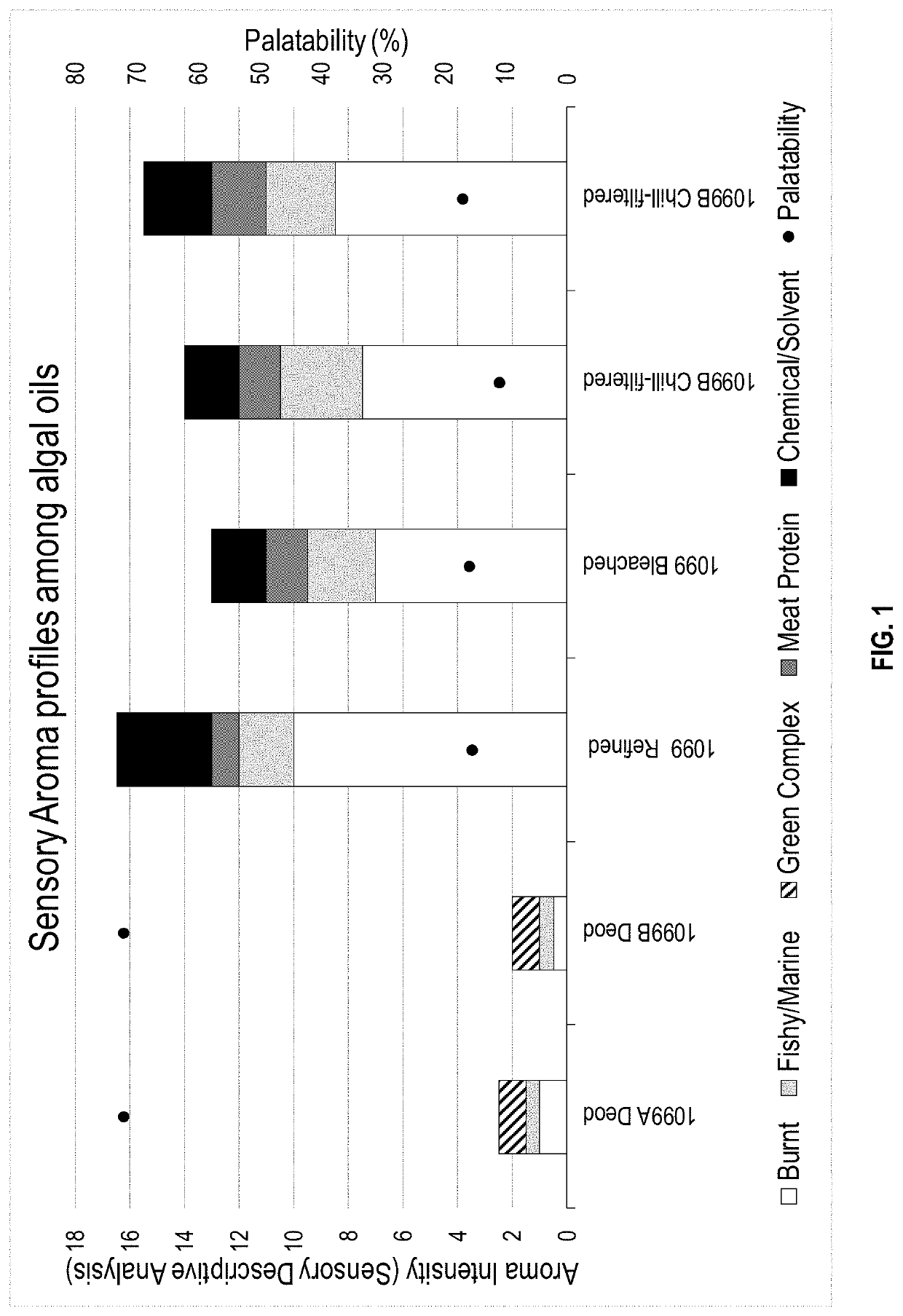Polyunsaturated fatty acid containing food ingredient with enhanced palatabilty and method for manufacturing the same
- Summary
- Abstract
- Description
- Claims
- Application Information
AI Technical Summary
Benefits of technology
Problems solved by technology
Method used
Image
Examples
example 1
PUFA Oil Samples and Processing Methods
[0073]A crude algal oil used in this invention was extracted from the biomass of Schizochytrium strain ATCC PTA-10208 without further processing. Different batches of this type of crude algal oil were produced and used in this invention.
Purification Processes
[0074]The above crude algal oil was processed by one or more of the purification steps described below.
Refinement
[0075]In this refinement step, a crude algal PUFA oil(s) was heated to 50-55° C. under nitrogen. Next, about 2% phosphoric acid was added and then mixed for 15 minutes. Based of the amount of crude free fatty acids (crude FFA) in the crude algal oil, the amount of 50% caustic solution and soft water for making a caustic / H2O solution was calculated using the formula below. Excess caustic factor was increased to account for neutralizing phosphoric acid.
50% Caustic=[(0.142×Crude FFA)+3.7]×Crude algal PUFA oil wt (kg) / 50
H2O=0.05×Crude algal PUFA oil weight (kg)
[0076]The caustic / H2O s...
example 2
Pet Food Palatability Animal Test
[0087]Pets such as domestic dogs and cats have different nutritional requirements and are sensitive to numerous palatability drivers. The animal food preference test used here is designed to identify the preference of PUFA-containing food by the tested animals.
[0088]In preference testing, animals have the choice between two different diets presented simultaneously. This is also called two-bowl test. In this two-bowl test, it is compared that how much of two foods, presented simultaneously, is eaten in a defined period of time. This is the most common test used in expert panels for dog and cat palatability assessment studies. It compares two products and establishes a preference based on the difference of quantities consumed. In such tests, two identical bowls were delivered simultaneously to the tested animal, each bowl containing one of the two products to be tested (A or B). The animal has free access to the bowls for a preset period of time. The q...
example 3
[0091]In order to identify the impact of each of the steps in the PUFA oil purification process, algal oil samples processed by one or more of the refinement, bleach, winterization and deodorization steps described in Example 1 were collected. Palatability of these oil samples were measured using the testing protocol described in Example 2. The testing samples include an unprocessed crude algal oil as described in Example 1, and oils which were refined, and / or bleached, and / or winterized.
[0092]A commercial fish oil sample was purchased from pet food producer and was labeled “RC fish oil”. This oil was refined, bleached, and deodorized by its manufacture before it was purchased.
[0093]The “RC fish oil” was used as a control oil, and it was compared with the testing oil samples described above. The test results are summarized in Table 2.
[0094]Data in Table 2 shows that when an unprocessed crude algal oil was refined, bleached and winterized but was not yet deodorized, the improvement ...
PUM
 Login to View More
Login to View More Abstract
Description
Claims
Application Information
 Login to View More
Login to View More - R&D
- Intellectual Property
- Life Sciences
- Materials
- Tech Scout
- Unparalleled Data Quality
- Higher Quality Content
- 60% Fewer Hallucinations
Browse by: Latest US Patents, China's latest patents, Technical Efficacy Thesaurus, Application Domain, Technology Topic, Popular Technical Reports.
© 2025 PatSnap. All rights reserved.Legal|Privacy policy|Modern Slavery Act Transparency Statement|Sitemap|About US| Contact US: help@patsnap.com

